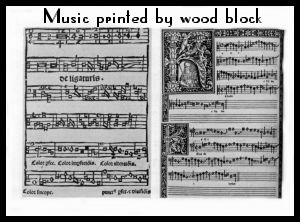We have all learned now that stories were traditionally passed down orally, then turned into handwritten books and finally, with the invention of the wonderful Gutenberg Printing Press in 1445, were finally printed. This made the art of making books much cheaper and efficient. But have you ever thought of how music was printed? Music also took its transition from being passed down orally to being handwritten and decorated, just like the music we saw in class a few weeks ago on vellum. People spent much of their time making sheet music in this way, but, as it was such a time consuming process, most people simply stuck to the old tradition of transferring their knowledge of music orally.
When music was printed at that time (around the 1450s), the staff lines were printed and later, the notes were added manually. It was just so much harder to come up with all of the symbols for music on a typeface than the 26 letters in the English language.
However, around the 1470s, the first actual printed music was made. How did they do this? Well, I will quickly point you to Scott's post about woodcutting! This process was used to first print sheet music! Carving around all those notes would sure be fun, wouldn't it?
European peoples continued to develop the art of music printing to find a way to use the Gutenberg Press to print their music. It took a long time and, for the most part, using the woodcutting technique was utilized. However, finally, a system was figured out in which the music would be printed in multiple stages. First, the staff lines would be printed onto the paper. After this dried, the typeface for the music notes would be lined up with the staff notes (perfectly lined up-how frustrating!) and printed and, Voila, you have yourself a nice printed piece of sheet music!
How much easier is it to print music today? To compose it, you can simply insert notes into a computer program or simply play the notes you want on a digital keyboard and have the notes show up on your computer. Hook it up to a printer, click the magical print button, and you're done! How cool is that? How do you think print in music allowed the spread of the knowledge of knowing how to sing or play an instrument?

This post made me think! You just kind of assume that when the Gutenberg Press was developed that it solved all of the possible printing needs. I had never considered how different it would be to print music. I'm sure this allowed for the spread of different cultural music and styles to different parts of the world. What a great application to the influence of print.
ReplyDeleteNo, I never had thought about how they printed music before. Come to think of it, I've hardly even wondered how they do in modern times... But this is very interesting. My question is, how have the actual musical symbols changed over time, and have they gotten more or less complex with the advent of printing?
ReplyDeleteI am bewildered by musical notes and I deeply respect those people who have taken the effort to know how to read a sheet of music. One day, when I was bored, I decided to learn the Cyrillic alphabet, and it only took me a few hours to grasp a basic understanding of it. However, I don't think that I could ever learn how to read a single musical note. As foreign as a language like Russian is, musical notes are so much more foreign to me!
ReplyDeleteWow, I really appreciated this post as i actually played the trumpet and piano through high school and never thought about the music printing process being any different than other prints. Very cool, to answer Sam, I would assume that the musical symbols have stayed mostly the same or possibly less complex with the advent of printing as it seems the process Jenna described could not yield some of the complex shapes and symbols the hand of say Mozart or Bach would write.
ReplyDeleteMarc, the "alphabet" of music is really not that complicated. You could definitely learn it in just a few hours!
ReplyDeleteJenna, I would think that printed music would have helped to standardize specific songs that maybe were just kind of played by ear and changed depending on who played them before widespread circulation of a printed version.